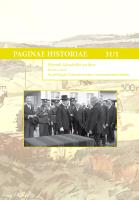Menová odluka ČSR a falšovanie československých bankovkových kolkov v rokoch 1919–1920 v medzinárodnom porovnaní
Currency separation of Czechoslovakia and counterfeiting of the Czechoslovak banknote validation stamps in 1919–1920 in international comparison
Author(s): Zbyšek ŠustekSubject(s): History, Economic history, Political history, Interwar Period (1920 - 1939)
Published by: Národní archiv
Keywords: monetary separation; stamps; forgery; crime; finance
Summary/Abstract: Dissolution of Austro-Hungary in late 1918 also resulted in the monetary disintegration of its former territory. It started in Czechoslovakia by secrete conceptual preparations already before the monarchy collapse and publicly in Kingdom of Serbs, Croats and Slovenes on 12 December 1918 by prohibition of import of the Austro-Hungarian banknotes. The disintegration was closed in Czechoslovakia by the currency reform in Ruthenia in November 1920 and in Italy in 1921 by withdrawal of the last unstamped Austro-Hungarian banknotes in some small islands in Adriatic sea. Transition to new currencies was carried out in four modes: (1) direct exchange for national currency (Italy, Poland, Czechoslovakia in Ruthenia 1920), (2) overprinting of banknotes (1000 crown notes in Czechoslovakia, Austria, Hungary), (3) hand-stamping of banknotes (Kingdom SCS January 1919, Romania, Fiume 1919 and 1920), (4) application of adhesive stamps (Czechoslovakia, Kingdom SCS September 1919).In all states having marked the Austro-Hungarian banknotes the used stamps or overprints were largely counterfeited from very different motives. All modes of marking exhibited considerable technical imperfections that made the counterfeiting easy and the counterfeits difficult to recognize. In this way, serious disturbances in money circulation and economical damages arose. The extent of counterfeiting in individual states is known to a very different degree. The most detailed information is available in Czechoslovakia, where 156 types of counterfeits were distinguished and at the time of circulation of the stamped banknotes, the counterfeits in the value of 255 millions crowns were recorded. However, the analysis of the preserved banknotes, where about one half of counterfeited stamps had not been identified as false, indicate that the real values of counterfeits could reach 500 millions crowns, hence even 10% of the then money circulation.The highest extent of counterfeits was identified, basing on the amount of officially stamped banknote and of the stamped banknotes presented for exchange for lei, to about 62% of money circulation.Similarly in Kingdom SHS, the amount of counterfeited stamps from the first statistical stamping in January 1919 was estimated only indirectly to about 4–5% of the money circulation. The extent of counterfeiting of stamps from the second stamping is officially unknown, in spite of the fact, that 10 types of false stamps attached on 1000-crown notes were recorded.The extent of counterfeiting of stamps in Fiume is exactly unknown. Originally, it was taken as enormously high, but on the protests of citizens all suspect stamps were finally declared as genuine or unrecognizable and let in circulation.In Hungary, the counterfeits were recorded already during the stamping. There exist many stamps marked as false, but the exact data are still unknown.In Austria a special situation occurred. Until April 1920, only mostly individual primitive counterfeits of 19 types on small banknotes were recorded. As late as in mid-April an explosion of occurrence of counterfeited overprints on 1000- and 10,000-crown notes appeared. The available data indicate that their values reached several millions of crowns, but the real extent was probably much higher. The total number of officially known types of counterfeits reached 30, but probably was higher. The Austro-Hungarian bank compensated them to most owners by unstamped notes that could be sold in free devise marked with a los of 10-20%. It also compensated the banknotes with false Czechoslovak or Yugoslav stamps, if the owner presented confirmation of the Czechoslovak or Yugoslav authorities, that the stamps are false. The timing of explosion of occurrence of false Austrian overprints coincides with end of legal circulation of unstamped notes in Poland and Italy and with the delayed stamping in Hungary.
Journal: Paginae Historiae
- Issue Year: 31/2023
- Issue No: 1
- Page Range: 147-218
- Page Count: 72
- Language: Slovak

